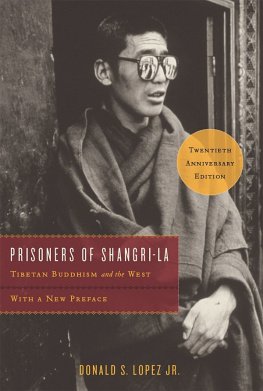Contents
Guide

2020 International Campaign for Tibet
All rights reserved.
ISBN: 978-1-879245-00-6
Cover design and layout by Studio Red Design
Cover photo of Ngawang Sangdrol by Tom Stoddard
Cover photo of Drapchi prison by ICT

ACKNOWLEDGEMENTS
ICT wishes to thank Unione Buddhista Italiana (UBI), Library of Tibetan Works and Archives (LTWA), Sangye Tandar Naga, Thupten Samphel, Yeshi Choedak, Ngawang Sangdrol, Gyaltsen Dolker, Yeshi Dolma Karushar, Palden Choedon, Phuntsog Nyidron Sanaschiga, Rinzin Choekyi, Rinzin Chonyi, Sonam Choedon, and Thinley Choezom.
A NOTE FROM ICT PRESIDENT MATTEO MECACCI
In the early 1990s, Lhasas notorious prisons held hundreds of Tibetan political prisoners following their participation in demonstrations against Chinas misrule in Tibet. Among them were a group of fourteen nuns, mostly from Garu nunnery near Lhasa, who were imprisoned in the dreaded Drapchi Prison in Lhasa. On account of their comradeship and solidarity, including in recording a song in praise of His Holiness the Dalai Lama and Tibet, they came to be known as the Drapchi 14. Specifically, in 1994, the nuns clandestinely recorded songs and poems in tribute to Tibet and His Holiness the Dalai Lama from inside Drapchi prison. The recording made it out of Tibet and the international community heard the haunting songs telling the hardships of prison life and the womens undying cry for freedom.
This book tells the story of nine of those nuns and provides a better understanding of the role played by Tibetan nuns in the Tibet freedom movement. Through their personal stories, we are able to have a sense of their life in Tibet, of their motivation to speak up against oppression despite the certainty that they would be severely punishedand of the importance of Tibetan religion, culture and identity, and why the world should not forsake the Tibetan people.
I would like to thank in particular Ngawang Sangdrol, one of the former nuns, who accepted to coordinate the compilation of the stories. I also wish to express my deep gratitude to all the nuns who took the time to write down their stories of courage and resilience for this book. I also thank Mr. Sangye Tandar Naga for editing the manuscript in Tibetan and Mr. Thubten Samphel and Ven. Yeshi Choedak for translating it into English.
I thank the Italian Buddhist Union for providing us with a grant for this project and the Library of Tibetan Works and Archives for accepting to publish the Tibetan language edition.
Matteo Mecacci
PRESIDENT
INTERNATIONAL CAMPAIGN FOR TIBET
T HIS BOOK IS ABOUT THE STORIES OF NINE YOUNG Tibetan nuns and their experiences, about how they renounced the worldly life and entered nunneries like Michungri, Gari Samtenling and Shugsep Ugyen Dzong around Lhasa that were established in the 12th century. These stories are written by the nine nuns themselves. While in these nunneries, they studied with great enthusiasm and at the same time helped to happily renovate their nunneries, which were destroyed during the Cultural Revolution. Their admission to the nunneries coincided with the era of rebuilding that followed the death of Mao Zedong.
Readers should note that traditionally there was no other important responsibility for Buddhist practitioners other than the wheels of study and contemplation. As said by the Master Vasubandhu, The only two Buddha Dharmas are the teachings and spiritual realization. The teaching can be preserved by learning, and realization can be cultivated by meditation.
However, later, the nuns as necessitated by the prevailing social conditions had to involve themselves in the action wheel of dharmic activity, too. While being involved in the study wheel of learning, the renunciation wheel of contemplation, and the action wheel of dharmic activity, forces of the government of the Chinese Communist Party carried out a policy of repression in their homeland which left no Tibetan family untouched and unscathed by violence. Particularly, when they knew and experienced this repression in their own families and realizing that they had no opportunity or the environment to practice their religion, the nuns secretly decided to express their feelings, and openly and nonviolently at the risk of their own cherished lives staged protest demonstrations against the armed Chinese forces. This book consists of the stories of the torture and pain the nuns went through because of their nonviolent resistance against Chinese oppression.
The nine nuns are Gyaltsen Dolker, Yeshi Dolma, who goes by the ordained name of Ngawang Rigdol, and Ngawang Sangdrol from Gari Samtenling nunnery; Palden Choedon, Rinzin Choekyi and Rinzin Chonyi from Shugsep Ugyen Dzong nunnery; and Phuntsog Nyidron Sana-schiga, Sonam Choedon and Thinley Choezom from Michungri nunnery.
Their collective and nonviolent slogans are as follows: Tibet is independent; Dont hoist Chinas flag on Tibetan territory; Our people are facing the risk of being killed; Long live His Holiness the Dalai Lama; Throw out the Chinese army from Tibet; Tibet belongs to Tibetans; and Release all political prisoners.
On account of their protests, even though they were nonviolent, the nuns suffered unimaginable beating and torture. All these are made clear in this book. These nuns experienced this in Gutsa Even while in the prisons, unlike other prisoners, these nuns made every possible effort to express their resistance against the Chinese government. Their resistance was shown in the form of hunger strikes, not showing respect for Chinese prison wardens or prison discipline, not tidying up their beds the way the authorities wanted, shouting slogans for Tibetan independence and for the long life of His Holiness the Dalai Lama, etc. If one nun got into trouble, the others went to her aid, to the extent of being able to save her life.
I believe that all these nuns love their country and their people to the extent they were willing to sacrifice their lives for them. In everyday life, each and every one of them is humbler than the other, but when it comes to the cause of Tibet they are all Tibetan patriots. For this they deserve flowers of praise. Below is an example of the songs they wrote, transmitted outside and sang in prison.
The melodies that we sang in prison
Buried in the mine of history
Were heard by the merciless rulers
Who transported us to the land of darkness and sorrow
Our feelings of the dark prison conditions
When we sang them in songs
The horse of good fortune fell off the cliff














